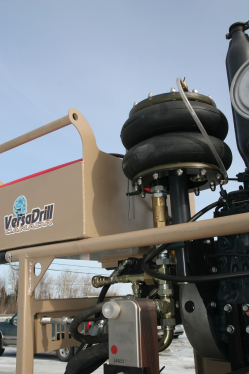
Expanding Possibilities
By André Voshart
Fluid Power hydraulicsVariable volume reservoir solves weighty hydraulic problem
“For some applications, a classic reservoir is the only solution,” Seguin says. “For lubricating systems, the returning oil is very foamy and a long settling time is required to eliminate air and foam. Also, tank convection can be the only solution to cool oil, if a water cooler can’t be used because a problematic water supply or a dusty environment does not allow for an air-oil cooler. Large differential cylinders and accumulator banks also make the use of the VVR impractical.”
To create his compact invention, Seguin drew inspiration from the bootstrap reservoirs used on military and commercial aircraft. These reservoirs keep the charge inlet of pumps pressurized to prevent cavitation and allow machinery to operate in any orientation and altitude.
While similar, the 400-in.3, 6.6-litre VVR improves upon the bootstrap concept through the use of its expanding and contracting bellows, which keeps the fluid sealed from the atmosphere, air free and pressurized using a compression spring (up to 9 psi or 0.6 bar) located inside a guide-tube to prevent buckling to minimize the dead fluid volume and thermal expansion effects. Seguin says the fact the VVR is sealed and air free protects the hydraulic fluid from contaminants and moisture, thus prolonging fluid and component life.
As for its location, the unit can be installed in line or off line depending on the user preference, between the main system-return line and the pump inlet. On hydrostatic drive systems, it should be located in the charge pump circuit. It can also operate in any orientation, but preferably with the bellows facing up for air bleeding purposes if no other bleeding point is assigned in the network.
Since the concept was first considered in 1991, Seguin says the VVR has been continuously tested and improved over the last six years. The company now offers several models that can be used in varied applications looking to reduce oil quantity, lower weight and space requirements and meet disposal/environment regulations. These include hydrostatic drive systems and most open and close-loop fluid power systems that control one or many hydraulic motors and/or rotary actuators for the mobile, industrial, marine, agriculture and mining industries.

